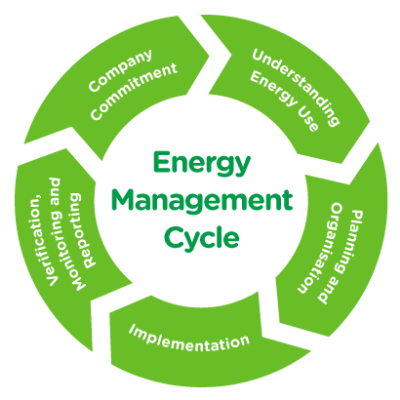How to identify energy efficiency drivers and barriers
Energy management encompasses a wide range of activities and expertise in the optimal use of energy.
This includes the areas of:
- Development of management strategies programmes and plans
- Implementation of techniques, technology and tools
- Measurement, verification and control.

The energy management cycle includes:
- Company commitment
- Understanding energy use
- Planning and organisation
- Implementation
- Verification, monitoring and reporting
The opportunity
Improving energy management practice in New Zealand improves business through reduced costs and reduced environmental impact (including reduced GHG emissions).
Research shows that New Zealand business can reduce their energy costs by 20% for no or little cost. This is based on extrapolation of 50 commercial and industrial sector Energy Audits carried out since 2010 with a combined total energy use of 1,082 GWh/yr. The results from the survey showed:
No cost savings = 2%, 0-1 year payback savings = 7%, 1-5 year payback savings = 12%, 5+years payback savings = 7%. Total savings 0-5 yrs = 21%.
The drivers
Economic: Electricity and other energy prices are rising, investment in energy network infrastructure is ramping up, Average energy prices have risen 6.7% annually since 2002. Technology for using energy more efficiently is constantly improving.
Political: New Zealand is paying for its greenhouse gas emissions. Reducing energy waste just makes good policy sense – it reduces exposure to the price of carbon, makes business more productive, helps manage energy risks, and contributes to our clean green international image.
Environmental: Reducing energy waste does not only reduce GHG emissions, but it reduces the need for marginal energy supply infrastructure, and all of the accompanying environmental impacts.
Social: Energy efficiency has health benefits, both in the home and at work – and getting more energy services for the same amount of energy makes it more affordable. A more productive heating and cooling system is generally also a more effective system.
Technological: By implementing energy efficient technologies into New Zealand’s economy, we enhance the experience of New Zealand’s workforce in working with technology and improve the opportunities for New Zealand based technological solutions.
The barriers
Information and skill gaps: There are a wide range of skills needed; from understanding the benefits of improving energy use, through to the engineering skills needed to install and optimise energy using equipment.
Information asymmetries: When two parties do not have equal access to information. For example, a building owner may not be able to tell the difference between a competent and incompetent energy efficiency serviced provider, or the full cost implications of two different energy using plant and equipment.
Bounded rationality: Using the old “rule of thumb” to problems that require a different structure to the decision making process. For example, an energy efficiency upgrade may save significantly on energy costs but the maintenance departments budget is the only part of the business that considers asset replacement, and energy costs are ignored or under estimated in their decision making.
Principal-Agent problems: Improving energy efficiency can have multiple benefits to multiple people, but the costs may not align with the benefits. For example, a tenant may pay the electricity bill which does not directly impact on the landlord, so the landlord may not want to invest in more efficient heating, cooling, air conditioning or insulation.
Economic externalities: As with Principal-agent problems, if someone does not pay for the full costs of damage they cause, or receive the full benefit from what they pay, then decision making will be inferior.
Regulatory Problems: Capturing the full benefits of an energy efficiency improvement can run into problems when trying to reduce capacity from a supply company that has regulatory incentives to invest in maximum capacity infrastructure, and not have a primary incentive to consider the long term interests of the consumer.
